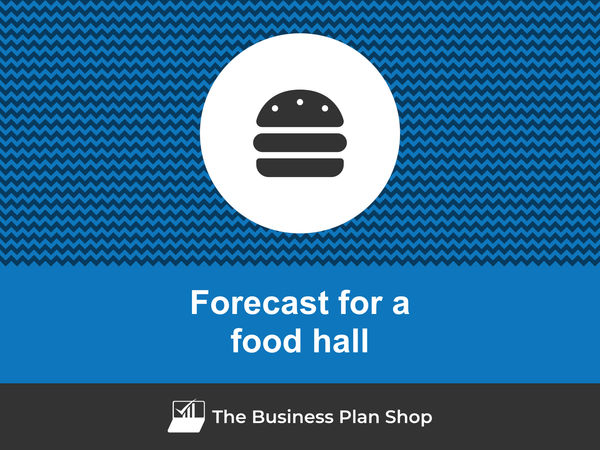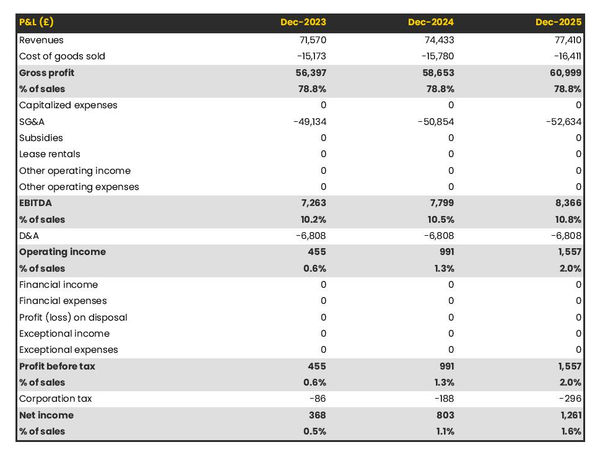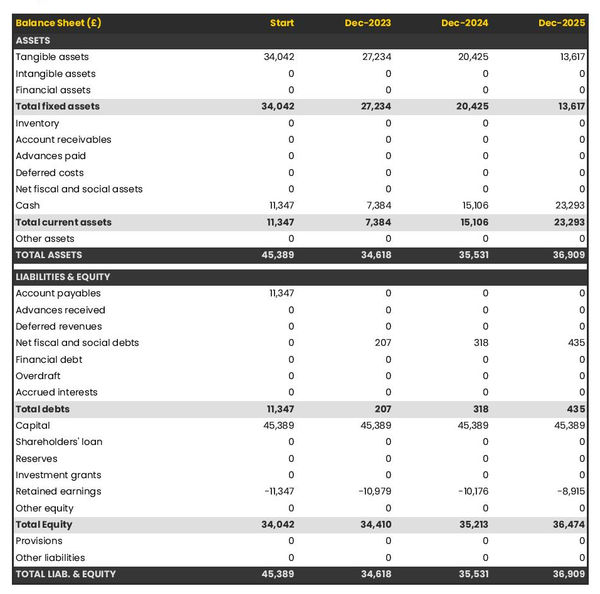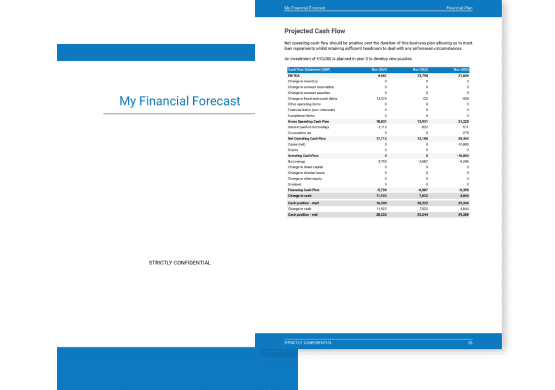How to create a financial forecast for a food hall?

Developing and maintaining an up-to-date financial forecast for your food hall is key in order to maintain visibility on your business’s future cash flows.
If you feel overwhelmed at the thought of putting together a food hall financial forecast then don’t worry as this guide is here to help you.
We'll cover everything from: the main objectives of a financial forecast, the data you need to gather before starting, to the tables that compose it, and the tools that will help you create and maintain your forecast efficiently.
Let's get started!
Why create and maintain a financial forecast for a food hall?
The financial projections for your food hall act as a financial blueprint to guide its growth with confidence and ensure its long-term financial viability.
To create them, you will need to look at your business in detail - from sales to operating costs and investments - to assess how much profit it can generate in the years to come and what will be the associated cash flows.
During challenging market conditions, maintaining an up-to-date financial forecast enables early detection of potential financial shortfalls, allowing for timely adjustments or securing financing before facing a cash crisis.
Your food hall's financial forecast will also prove invaluable when seeking financing. Banks and investors will undoubtedly request a thorough examination of your financial figures, making precision and presentation essential.
Need a solid financial forecast?
The Business Plan Shop does the maths for you. Simply enter your revenues, costs and investments. Click save and our online tool builds a three-way forecast for you instantly.

What information is used as input to build a food hall financial forecast?
A food hall's financial forecast needs to be built on the right foundation: your assumptions.
The data required to create your assumptions will depend on whether you are a new or existing food hall.
If you are creating (or updating) the forecast of an existing food hall, then your main inputs will be historical accounting data and operating metrics, and your team’s view on what to expect for the next three to five years.
If you are building financial projections for a new food hall startup, you will need to rely on market research to form your go-to-market strategy and derive your sales forecast.
For a new venture, you will also need an itemised list of resources needed for the food hall to operate, along with a list of equipment required to launch the venture (more on that below).
Now that you understand what is needed, let’s have a look at what elements will make up your food hall's financial forecast.
The sales forecast for a food hall
From experience, it is usually best to start creating your food hall financial forecast by your sales forecast.
To create an accurate sales forecast for your food hall, you will have to rely on the data collected in your market research, or if you're running an existing food hall, the historical data of the business, to estimate two key variables:
- The average price
- The number of monthly transactions
To get there, you will need to consider the following factors:
- Location: The location of your food hall can greatly impact the average price and number of monthly transactions. A prime, high-traffic location in a popular area may allow you to charge higher prices and attract more customers, while a less desirable location may result in lower prices and fewer transactions.
- Seasonal Trends: The time of year can also affect your average price and number of monthly transactions. For example, in the summer months, customers may be more likely to purchase lighter, cooler foods and drinks, resulting in lower average prices. On the other hand, in the winter months, customers may be more inclined to purchase warm, hearty dishes, resulting in higher average prices.
- Competition: The presence of other food halls or restaurants in the area can also impact your business's sales. If there are many competitors offering similar types of food, you may need to lower your prices or offer unique menu items to attract customers. Alternatively, if you are the only food hall in the area, you may be able to charge higher prices and attract more customers.
- Menu Offerings: The types of food and drinks you offer can also affect your average price and number of monthly transactions. If you offer a diverse menu with a variety of options, you may be able to attract a wider range of customers and charge higher prices. However, if your menu is limited or does not cater to a specific dietary preference, you may see lower prices and fewer transactions.
- Economic Conditions: The state of the economy can also play a role in your business's sales. In a strong economy, customers may be more willing to spend money and may be less price-sensitive, resulting in higher average prices. However, in a weaker economy, customers may be more budget-conscious and may seek out lower-priced options, resulting in lower average prices.
Once you have an idea of what your future sales will look like, it will be time to work on your overhead budget. Let’s see what this entails.
Need inspiration for your business plan?
The Business Plan Shop has dozens of business plan templates that you can use to get a clear idea of what a complete business plan looks like.

The operating expenses for a food hall
The next step is to estimate the expenses needed to run your food hall on a day-to-day basis.
These will vary based on the level of sales expected, and the location and size of your business.
But your food hall's operating expenses should include the following items at a minimum:
- 1. Staff costs: This includes salaries, wages, and benefits for all employees working in the food hall, such as chefs, servers, and cashiers. You will also need to budget for payroll taxes and other employee-related expenses. 2. Accountancy fees: As a business owner, you will need to hire an accountant to help you with bookkeeping, tax preparation, and financial reporting. These services come at a cost, so make sure to include them in your operating expenses. 3. Insurance costs: It is essential to have insurance coverage for your food hall to protect against any potential risks, such as property damage, liability claims, or employee injuries. The cost of insurance will depend on the size and location of your food hall. 4. Software licenses: To run your food hall efficiently, you will need to invest in various software programs, such as point-of-sale systems, inventory management software, and accounting software. These programs usually require annual or monthly license fees. 5. Banking fees: As a business owner, you will need to maintain a business bank account to handle all financial transactions related to your food hall. These accounts usually come with monthly maintenance fees and transaction fees. 6. Rent: Unless you own the property, you will need to budget for monthly rent payments for your food hall. The cost of rent will vary depending on the size and location of your food hall. 7. Utilities: This includes electricity, water, and gas expenses for your food hall. These costs can add up quickly, so make sure to budget for them accordingly. 8. Food and beverage costs: As a food hall, your main expense will be the cost of ingredients and supplies for the food and beverages you serve. Make sure to factor in fluctuations in food prices and seasonality. 9. Marketing and advertising: To attract customers to your food hall, you will need to invest in marketing and advertising efforts, such as social media ads, flyers, and promotions. These costs should be included in your operating expenses. 10. Cleaning and maintenance: A clean and well-maintained food hall is essential for the health and safety of your customers. Budget for regular cleaning services as well as maintenance costs for equipment and facilities. 11. Waste disposal: Proper waste management is crucial for a food hall. Make sure to budget for waste disposal services or invest in recycling programs to reduce costs. 12. Supplies: From napkins and cutlery to cleaning supplies and office materials, there are various supplies that a food hall needs to operate. Make sure to budget for these ongoing expenses. 13. Repairs and maintenance: As with any property, your food hall will require occasional repairs and maintenance. Budget for unexpected costs such as equipment breakdowns or plumbing issues. 14. Professional development: To stay competitive in the food industry, it's important to invest in your own professional development and that of your staff. This could include attending conferences, workshops, or training programs. 15. Contingency fund: Finally, it's always a good idea to have a contingency fund for unexpected expenses or emergencies. This can help you avoid dipping into your personal funds or taking out a loan in case of unforeseen circumstances.
This list is, of course, not exhaustive, and you'll have to adapt it according to your precise business model and size. A small food hall might not have the same level of expenditure as a larger one, for example.
What investments are needed to start or grow a food hall?
Once you have an idea of how much sales you could achieve and what it will cost to run your food hall, it is time to look into the equipment required to launch or expand the activity.
For a food hall, capital expenditures and initial working capital items could include:
- Kitchen Equipment: This includes items such as ovens, stoves, refrigerators, and other necessary equipment to prepare and store food in the food hall.
- Furniture and Fixtures: This can include tables, chairs, booths, and other furnishings needed to create a comfortable and inviting dining space for customers.
- POS System: A point-of-sale system is essential for processing orders, tracking sales, and managing inventory in a food hall setting.
- Renovations and Build-Out: Depending on the space being used for the food hall, there may be costs associated with renovations and build-out to create a functional and attractive dining area.
- Technology and Audiovisual Equipment: This category can include items such as digital menu boards, sound systems, and other technology needed to enhance the customer experience in the food hall.
Again, this list will need to be adjusted according to the specificities of your food hall.
Need a convincing business plan?
The Business Plan Shop makes it easy to create a financial forecast to assess the potential profitability of your projects, and write a business plan that’ll wow investors.

The financing plan of your food hall
The next step in the creation of your financial forecast for your food hall is to think about how you might finance your business.
You will have to assess how much capital will come from shareholders (equity) and how much can be secured through banks.
Bank loans will have to be modelled so that you can separate the interest expenses from the repayments of principal, and include all this data in your forecast.
Issuing share capital and obtaining a bank loan are two of the most common ways that entrepreneurs finance their businesses.
What tables compose the financial plan for a food hall?
Now let's have a look at the main output tables of your food hall's financial forecast.
The projected profit & loss statement
The projected profit & loss shows how profitable your food hall is likely to be in the years to come.

For your food hall to be financially viable, your projected P&L should ideally show:
- Sales growing above inflation (the higher the better)
- Profit margins which are stable or expanding (the higher the better)
- A net profit at the end of each financial year (the higher the better)
This is for established food halls, there is some leniency for startups which will have numbers that will look a bit different than existing businesses.
The projected balance sheet
Your food hall's forecasted balance sheet enables you to assess your financial structure and working capital requirements.
It is composed of three types of elements: assets, liabilities and equity:
- Assets: represent what the business owns and uses to produce cash flows. It includes resources such as cash, equipment, and accounts receivable (money owed by clients).
- Liabilities: represent funds advanced to the business by lenders and other creditors. It includes items such as accounts payable (money owed to suppliers), taxes due and loans.
- Equity: is the combination of what has been invested by the business owners and the cumulative profits and losses generated by the business to date (which are called retained earnings). Equity is a proxy for the value of the owner's stake in the business.

The cash flow forecast
Your food hall's cash flow forecast shows how much cash your business is expected to consume or generate in the years to come.

It is best practice to organise the cash flow forecast by nature to better explain where cash is used or generated by the food hall:
- Operating cash flow: shows how much cash is generated by the operating activities
- Investing cash flow: shows how much will be invested in capital expenditure to maintain or expand the business
- Financing cash flow: shows if the business is raising new capital or repaying financiers (debt repayment, dividends)
Keeping an eye on (and regularly updating) your food hall's cash flow forecast is key to ensuring that your business has sufficient liquidity to operate normally and to detect financing requirements as early as possible.
If you are trying to raise capital, you will normally be asked to provide a monthly cash flow forecast in your food hall's financial plan - so that banks or investors can assess seasonal variation and ensure your business is appropriately capitalised.
Need a solid financial forecast?
The Business Plan Shop does the maths for you. Simply enter your revenues, costs and investments. Click save and our online tool builds a three-way forecast for you instantly.

Which tool should you use to create your food hall's financial forecast?
Using the right tool or solution will make the creation of your food hall's financial forecast much easier than it sounds. Let’s explore the main options.
Using online financial projection software to build your food hall's forecast
The modern and easiest way to build a forecast is to use professional financial projection software such as the one we offer at The Business Plan Shop.
There are several advantages to using specialised software:
- You can easily create your financial forecast by letting the software take care of the financial calculations for you without errors
- You have access to complete financial forecast templates
- You get a complete financial forecast ready to be sent to your bank or investors
- You can easily track your actual financial performance against your financial forecast, and recalibrate your forecast as the year goes by
- You can create scenarios to stress test your forecast's main assumptions
- You can easily update your forecast as time goes by to maintain visibility on future cash flows
- You have a friendly support team on standby to assist you when you are stuck
- It’s cost-efficient and much cheaper than using an accountant or consultant (see below)
If you are interested in this type of solution, you can try our forecasting software for free by signing up here.
Hiring a financial consultant or chartered accountant
Hiring a consultant or chartered accountant is also an efficient way to get a professional food hall financial projection.
As you can imagine, this solution is much more expensive than using software. From experience, the creation of a simple financial forecast over three years (including a balance sheet, income statement, and cash flow statement) is likely to start around £700 or $1,000 excluding taxes.
The indicative estimate above, is for a small business, and a forecast done as a one-off. Using a financial consultant or accountant to track your actuals vs. forecast and to keep your financial forecast up to date on a monthly or quarterly basis will naturally cost a lot more.
If you choose this solution, make sure your service provider has first-hand experience in your industry, so that they may challenge your assumptions and offer insights (as opposed to just taking your figures at face value to create the forecast’s financial statements).
Why not use a spreadsheet such as Excel or Google Sheets to build your food hall's financial forecast?
Creating an accurate and error-free food hall financial forecast with a spreadsheet is very technical and requires a deep knowledge of accounting and an understanding of financial modelling.
Very few business owners are financially savvy enough to be able to build a forecast themselves on Excel without making mistakes.
Lenders and investors know this, which is why forecasts created on Excel by the business owner are often frowned upon.
Having numbers one can trust is key when it comes to financial forecasting and to that end using software is much safer.
Using financial forecasting software is also faster than using a spreadsheet, and, with the rise of artificial intelligence, software is also becoming smarter at helping us analyse the numbers to make smarter decisions.
Finally, like everything with spreadsheets, tracking actuals vs. forecasts and keeping your projections up to date as the year progresses is manual, tedious, and error-prone. Whereas financial projection software like The Business Plan Shop is built for this.
Need a convincing business plan?
The Business Plan Shop makes it easy to create a financial forecast to assess the potential profitability of your projects, and write a business plan that’ll wow investors.

Use our financial projection templates for inspiration
The Business Plan Shop has dozens of financial forecasting templates available.
Our examples contain both the financial forecast, and a written business plan which presents, in detail, the company, the team, the strategy, and the medium-term objectives.
Whether you are just starting out or already have your own food hall, looking at our template is always a good way to get ideas on how to model financial items and what to write when creating a business plan to secure funding.

Takeaways
- A financial forecast shows expected growth, profitability, and cash generation metrics for your food hall.
- Tracking actuals vs. forecast and having an up-to-date financial forecast is key to maintaining visibility on your future cash flows.
- Using financial forecasting software is the modern way of creating and maintaining financial projections.
We hope that this guide helped you gain a clearer perspective on the steps needed to create the financial forecast for a food hall. Don't hesitate to contact us if you have any questions!
Need inspiration for your business plan?
The Business Plan Shop has dozens of business plan templates that you can use to get a clear idea of what a complete business plan looks like.

Also on The Business Plan Shop
Know someone who runs a food hall? Share our business guide with them!



